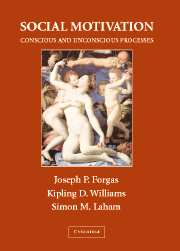Book contents
- Frontmatter
- Contents
- About the Editors
- List of Contributors
- Preface
- The Sydney Symposium of Social Psychology series
- 1 Social Motivation: Introduction and Overview
- PART I CONSCIOUS AND UNCONSCIOUS SOCIAL MOTIVATION: GENERAL ISSUES
- 2 Multiple Goals, Optimal Motivation, and the Development of Interest
- 3 The Machine in the Ghost: A Dual Process Model of Defense Against Conscious and Unconscious Death-Related Thought
- 4 Habits and the Structure of Motivation in Everyday Life
- 5 Motivation in Social Settings: Studies of Effort-Related Cardiovascular Arousal
- 6 Reflection and Impulse as Determinants of Conscious and Unconscious Motivation
- 7 The Role of Motivation in the Unconscious: How Our Motives Control the Activation of Our Thoughts and Shape Our Actions
- PART II SOCIAL MOTIVATION: COGNITIVE AND AFFECTIVE IMPLICATIONS
- PART III CONSCIOUS AND UNCONSCIOUS SOCIAL MOTIVATION: SOME CONSEQUENCES AND APPLICATIONS
- Author Index
- Subject Index
- References
4 - Habits and the Structure of Motivation in Everyday Life
Published online by Cambridge University Press: 04 August 2010
- Frontmatter
- Contents
- About the Editors
- List of Contributors
- Preface
- The Sydney Symposium of Social Psychology series
- 1 Social Motivation: Introduction and Overview
- PART I CONSCIOUS AND UNCONSCIOUS SOCIAL MOTIVATION: GENERAL ISSUES
- 2 Multiple Goals, Optimal Motivation, and the Development of Interest
- 3 The Machine in the Ghost: A Dual Process Model of Defense Against Conscious and Unconscious Death-Related Thought
- 4 Habits and the Structure of Motivation in Everyday Life
- 5 Motivation in Social Settings: Studies of Effort-Related Cardiovascular Arousal
- 6 Reflection and Impulse as Determinants of Conscious and Unconscious Motivation
- 7 The Role of Motivation in the Unconscious: How Our Motives Control the Activation of Our Thoughts and Shape Our Actions
- PART II SOCIAL MOTIVATION: COGNITIVE AND AFFECTIVE IMPLICATIONS
- PART III CONSCIOUS AND UNCONSCIOUS SOCIAL MOTIVATION: SOME CONSEQUENCES AND APPLICATIONS
- Author Index
- Subject Index
- References
Summary
INTRODUCTION
Many of the motivational challenges in daily life recur at routine intervals. For example, most appetitive drives (e.g., hunger, sleep) are cyclic, and people act to address them at certain times of the day in certain circumstances. Many other goals, such as getting to work or achieving physical fitness, also involve periodic activities that occur in specific, recurring times and places. This regularity in motivated behavior organizes everyday experience into repeated patterns of goal-directed activities in particular circumstances. With repetition of behavior in stable contexts, actions become automatic in the sense that deliberation about behavior becomes unnecessary. These well-practiced behaviors represent habits, and in this chapter we consider the role of habitual behavior in motivational processes.
A role for habits in motivated behavior was outlined early in classic learning theories, which specified how habits emerge from previous motivated responding and how they structure subsequent motivated responding. For example, Hull (1943, 1950) believed that habits are stimulus— response (S—R) linkages that develop when a given response is reinforcing because it successfully reduces a drive state such as hunger or thirst. This reinforcement increases the association between the stimulus and the response and thereby increases habit strength. Thus, habits orient people to repeat activities that have in the past successfully met motivational needs.
- Type
- Chapter
- Information
- Social MotivationConscious and Unconscious Processes, pp. 55 - 70Publisher: Cambridge University PressPrint publication year: 2004
References
- 13
- Cited by



